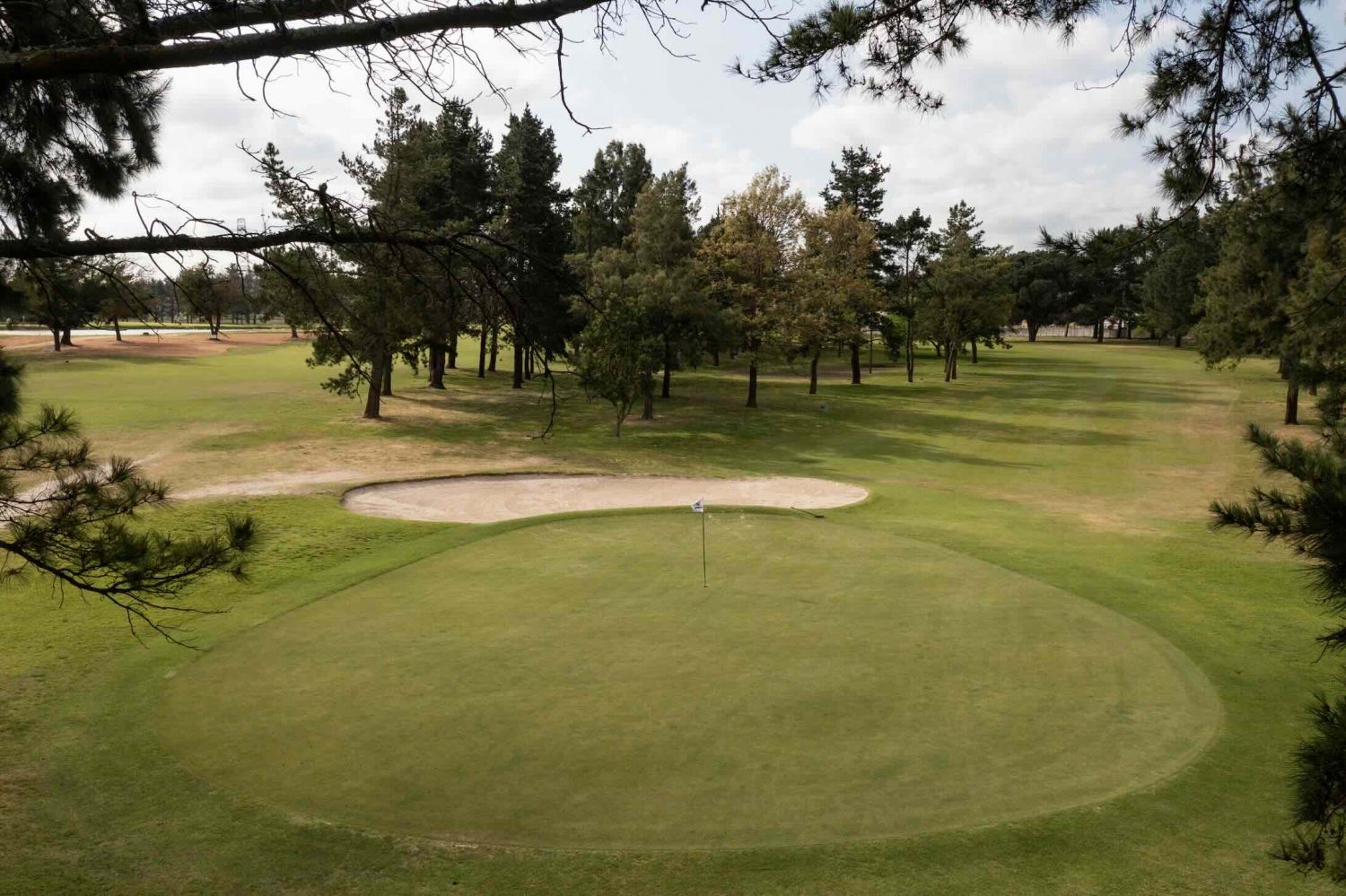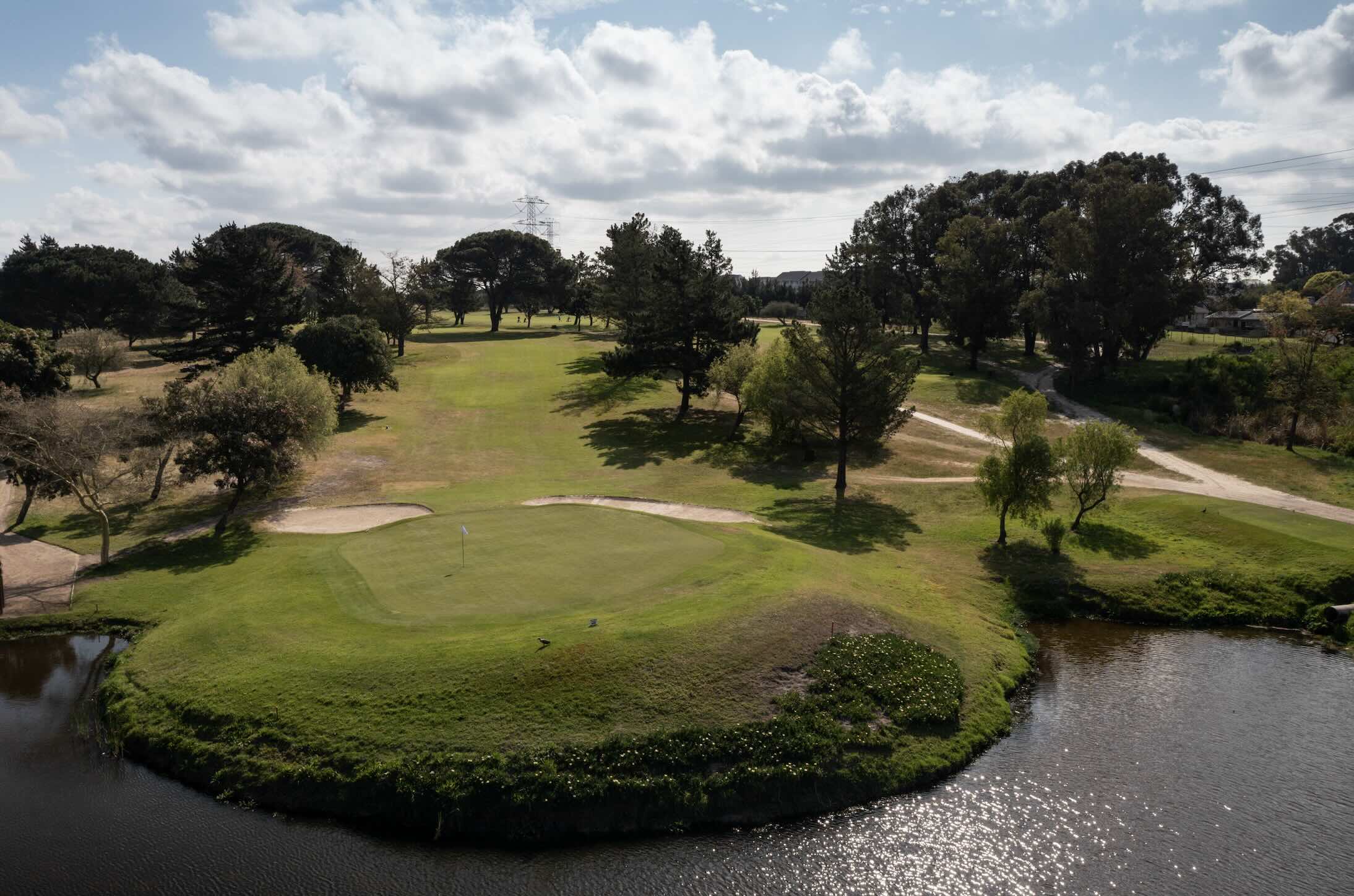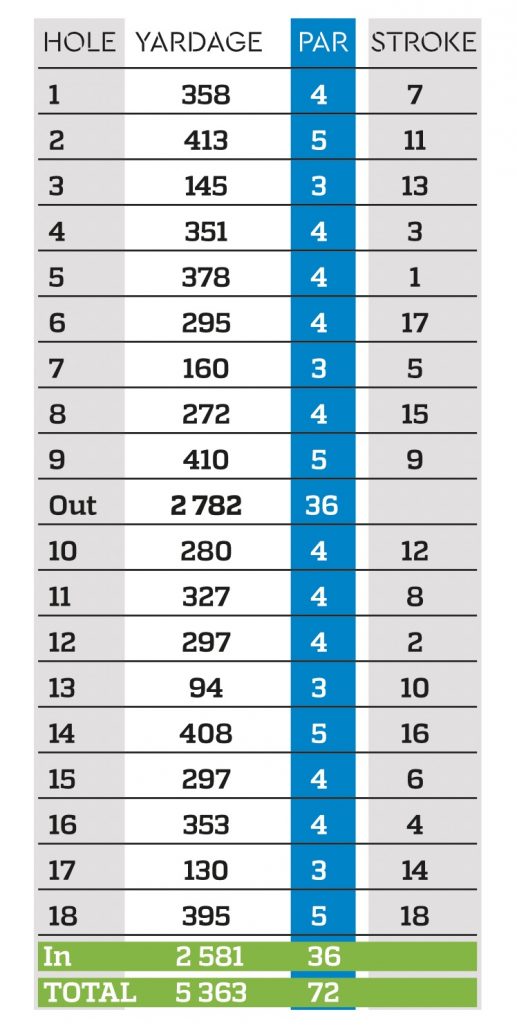Kuils River can be found 20km east of Cape Town city centre and is reputed to be the gateway to the Cape winelands, writes MARK SAMPSON.
Located at the base of the Bottelary Mountains, the Kuils River area dates back to 1680 when it was established by the Dutch East India Company as a refreshment post and known then as ‘De Boss’. Its growth gained momentum in the 1800s with the first church built in 1843, its first road in 1845 and railway station in 1862.
When arriving at Kuilsrivier Golf Club you can expect a well-designed, flowing clubhouse full of friendly, helpful staff. The large bar area is always a hive of activity with its patio leading out on to the course.
The course itself is not long at 5,363m off the club tees and 5,767m from the yellow championship tees. That said, its fairways are lined with large mature trees dictating a need for accuracy off the tee. Strong gradients can be expected due to the lay of the land, demanding careful club, and shot, selection. Don’t be fooled into thinking this course can be overpowered. It requires checking yardages, taking into account the windy conditions and shots to both elevated and greens below you.
The course starts with a seemingly innocuous par four. That said, if the south-easter – the common wind for the area – is up, then its 358m feels closer to 400m. The hole slides down to the green with out of bounds on the right. From the blue tee, a large tree 269m from the tee is well placed almost in the middle of the fairway. This stroke seven has a green only 21m deep with a bunker left. A strong starting hole.
You then navigate uphill with the first par five of the course. The hole slides from right to left and if you can thread the needle, this 413m-long hole suddenly offers a birdie opportunity. Greenside there is no danger at this 23m-deep surface.
Turning back, the first par three comes in the form of a short 145m hole with a stroke rating of only 13. Slightly downhill with a bunker right of the green, it should not cause much concern.
The downhill par-four 4th is the signature hole on the course (see below).
After the signature hole, the stroke one is next. Straight into the teeth of the south-easter, this 378m monster requires two well-struck shots to reach the green. Close to a 90-degree right-to left-dogleg can be expected with a large pine tree by the name of ‘Jonty’ 147m from the tee that must be avoided at all costs. The elbow of the dogleg is 188m from the tee. You don’t want too much club as you will run out of fairway due to the strong bend. On clearing the corner, you will still have a long iron into the green. The good news is there’s no danger to be found greenside.

The 7th is the longest par three on the course as well as the one with the lowest stroke index of three. Played over water, you can expect a small green only 20m deep protected by two bunkers in the front and water right. It requires a well-struck iron to reach and stay on the surface.
The closing hole on the front nine is a genuine birdie opportunity. Playing to a length of only 410m, this par five is reachable in two, especially with the wind assisting. A nice easy closing hole before a tasty halfway stop.
The back nine is just over 200m shorter than the front and starts with a short par four of only 280m. That said, the fairway is cut off by a water hazard 200m from the tee, so you need to double check yardage to leave the correct length for your favourite wedge into the green. Another small green awaits with out of bounds over the back.
A downhill par four then, with out of bounds down the left flank. The hole moves from left to right. With the elbow of the dogleg 200m from the tee box, you need to check your yardage and allow for the downhill lay of the fairway.

Turning back to play back up the hill, the strong par-four 12th follows. The stroke two is 297m long and has a variety of features making up for the low stroke rating. You need to navigate a tight chute of trees to reach the fairway, which has a large bunker left, which is then followed by a large water hazard. A driver may not be required from the tee but be sure you choose one of your more accurate clubs. The green has water left and a bunker right and playing uphill it can prove troublesome to stay on the surface.
At 94m long, the 13th is the shortest hole on the course. It plays over a water hazard to a semi-island green and the largest green on the course. With a stroke rating of 10, don’t be lulled into a false sense of security by its beauty.
Next up is a short, downhill par five of 408m. An accurate drive may well present a genuine birdie chance, while anything left will find a bunker and large mature pine trees. The green has a bunker short right and is only 19m deep, the smallest on the course, so does require a well-struck long-iron to reach it in two.
Turning back towards the clubhouse, the 15th is a short par four of 297m. A well-placed water hazard severs the fairway some 178m from the tee box. The long hitters may try their luck in clearing it with a carry of 220m but the stroke six has this rating for a reason. A long-iron from the tee to stay short of the water will leave another longish club into the green which is protected by a bunker left.
The 16th presents one of the stronger par fours on the course and generally plays into the wind. At 353m, its length is the main reason for the stroke-four rating. Very little danger can be expected from the straight par four if you manage to find the fairway. The hole plays a few degrees uphill so be sure to take both the wind and the rise in elevation into account when selecting your club for the approach.
The closing par three of the round is a short 130m playing downhill. A bunker right is the main danger with water short not really in play. The green also has quite a bit of space short and left allowing for a bail-out if required. The wind is the main protagonist of bogeys on this hole.
The round ends with a very friendly par five which is often aided by the wind from behind. At 395m, it screams for a finishing birdie to the round. Bunkers at about 190m from the tee protect either side of the fairway. Avoid them and it’s game on. Depending on your length, anything from a long-iron to 9-iron or even wedge may be left. The hole does rise towards the clubhouse and bunkers short, and long, await any miscalculation in yardage. At 30m deep, it is one of the larger greens, offering a generous target. Another indication of the club’s friendly nature.
You can’t help but notice the friendly staff as you make your way around the club from the well-stocked pro shop through to the large bar area. It is a club and membership with a no-frills, or pretences, atmosphere.
There’s a welcoming of guests and out-of-town visitors which can be felt from management through to staff and members. Clubs like this should be at the top of your ‘to play’ list when thinking about the Cape.
The casual, yet professional, atmosphere is reminiscent of a small town where you arrive as a guest and depart as a friend. The added bonus is the amazing value for money you can expect for both greenfees and food and beverages, with juniors barely having to open their wallets to enjoy the picturesque layout.
Be sure to keep De Boss of the East in mind for your next golfing outing.
SIGNATURE HOLE
4th hole, par four, 351m

This hole presents a number of challenges confirming its difficult stroke-three ranking. If the south-easter is up, you can expect a very tough crosswind causing havoc with accuracy and club selection on the approach. Just before the dogleg from left to right, a tree encroaches on the fairway 204m from the tee.
You may well consider either a 3-wood or driving iron from the tee in order to avoid the trouble in the landing area as both sides of the fairway are protected by large mature trees. The goal from the tee box would be to reach the elbow of the dogleg, leaving approximately 140m to the green. As there is a strong drop in elevation to the green, a 7-iron should suffice for most.
Be sure to get a good idea of wind strength and direction before reaching for your approach iron. The landing area can be well protected from the wind, making club selection and the right approach line slightly tricky.
The 25m-deep green makes for a decent target; however, it is fraught with danger. Two bunkers, left and right, protect the front of the green while anything long goes into a water hazard. With all the danger in play and if the wind is up, simply finding the green’s surface on the approach will be a win. The not-overly-large green presents a decent two-putt par.
This is not a hole to be overpowered and in trying to do so, you may end up pencilling in a large score. This hole demands a less aggressive strategy to avoid a large number. Definitely one of the more picturesque holes at Kuilsrivier Golf Club.
GREENFEES
Members
R165 9 holes R240 18 holes
Junior members
R30 9 holes R50 18 holes
Member guests
R232 9 holes R350 18 holes
Visitor affiliated
R265 9 holes R395 18 holes
Non-affiliated
R420 9 holes R620 18 holes
Golf cart
R265 9 holes R395 18 holes
ADDRESS
Bottelary Road, Kuils River, Cape Town
ROAD DISTANCES
Durban: 1,614km
Joburg: 1,377km
Bloemfontein: 980km
Gqeberha: 759km
Cape Town: 39km
CONTACT DETAILS
Email: [email protected]
Phone: (021) 903 0222
Website: www.kuilsriviergolfclub.co.za
– This article first appeared in the Summer 2024-25 issue of Compleat Golfer magazine.










